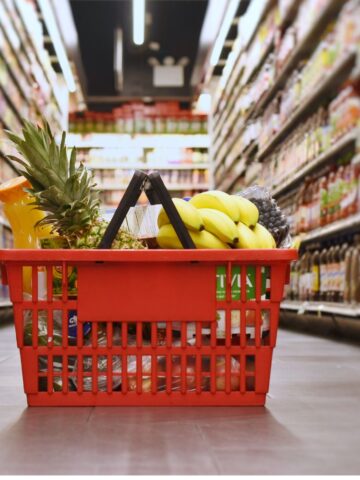Between work, school drop-offs and pick-ups, extracurricular activities, and other daily tasks, finding the time to plan meals and shop for healthy ingredients can feel overwhelming. And when you do find the time to shop, it can be frustrating to see the prices of healthy foods and feel like you have to settle for cheaper, less nutritious options. However, over the years, I've discovered a few tips and tricks for shopping for healthy ingredients on a budget.
By being intentional with my meal planning, shopping seasonal and local, buying in bulk, choosing whole foods, shopping the perimeter of the store, and not forgetting about frozen and canned foods, I've been able to provide my family with healthy and delicious meals without breaking the bank.
In this blog post, I'll be sharing these tips and more so that you too can shop for healthy ingredients on a budget. With a little planning and creativity, eating healthy doesn't have to be expensive or time-consuming. So let's get started!

Plan Your Meals and Shopping List
Meal planning is an essential step when it comes to shopping for healthy ingredients on a budget. As a busy mom, it can be challenging to find the time to plan meals, but it can save you both time and money in the long run. By planning out your meals for the week, you can avoid buying unnecessary items and ensure that you have all the ingredients you need for your meals. Additionally, meal planning can help you eat healthier by planning balanced meals and reducing food waste.
To create a weekly meal plan, start by deciding how many meals you need to plan for, including breakfast, lunch, dinner, and snacks. Next, look for recipe inspiration from cookbooks, websites, or Pinterest. When choosing meals, consider selecting dishes that use similar ingredients to save money. Additionally, batch cooking is a great way to save time and reduce waste by making larger portions and repurposing leftovers for future meals.
Once you've planned your meals, it's time to create a shopping list. Write down all the ingredients you need for your meals and check your pantry and fridge to see what you already have. Stick to your list when shopping to avoid buying unnecessary items. Consider opting for generic or store-brand options to save money. By following these meal planning and shopping list tips, you can provide your family with healthy and delicious meals without breaking the bank.
Shop Seasonal and Local Ingredients
Shopping for seasonal and local produce is a smart and affordable way to eat healthy while supporting your community! By choosing locally grown produce, you can enjoy fresher fruits and vegetables with better flavor and nutrition. Buying local reduces transportation costs and carbon footprint, making it a more environmentally conscious choice - which is great for you and everyone else.
To determine what's in season, research what produce is currently being harvested in your region. You can also check local farmers' markets or grocery stores for seasonal options. Consider subscribing to a community-supported agriculture (CSA) program to receive a weekly or monthly delivery of locally grown produce.
When shopping for local produce, try to plan your meals around what's in season to save money. You can also experiment with new fruits and vegetables that you may not have tried before. Shopping for local produce can be done at local farmers' markets, community-supported agriculture (CSA) programs, or even your local grocery store or co-op that sources from nearby farms. By supporting local farmers and buying seasonal produce, you can enjoy fresh and nutritious ingredients while supporting the environment and the local economy.
Buy in Bulk
Buying in bulk is a smart strategy for those looking to shop for healthy ingredients on a budget. This approach can help you save money by purchasing items that you frequently use at a lower cost per unit. In addition to saving money, buying in bulk is also environmentally friendly as it reduces packaging waste.
There are several items that are particularly well-suited to buying in bulk, including grains, legumes, nuts and seeds, spices, and cooking oils. These pantry staples are versatile and can be used in a variety of recipes.
When it comes to purchasing items in bulk, there are several options available. Wholesale clubs like Costco and Sam's Club are a popular choice, as are online retailers like Amazon and Thrive Market. You can also look for bulk food stores in your area.
To ensure that your bulk purchases stay fresh and don't spoil, it's important to store them properly. Grains and legumes should be kept in airtight containers in a cool, dry place. When buying in bulk, consider purchasing items with longer shelf lives to reduce food waste. By having essential ingredients on hand, you can save time and money by batch cooking and preparing meals in advance.
Overall, buying in bulk is a great way to save money while stocking up on healthy ingredients. By purchasing items in bulk, you can reduce packaging waste, ensure that you always have the ingredients you need on hand, and prepare healthy meals for your family without breaking the bank.
Choose Whole Foods When On A Budget
Choosing whole foods is a smart way to shop for healthy ingredients on a budget. Whole foods are minimally processed and nutrient-dense ingredients that are free from artificial additives and preservatives. By choosing whole foods, you can ensure that you're getting the most nutrition for your money.
Examples of whole foods include fruits and vegetables, whole grains like brown rice and quinoa, legumes such as beans and lentils, nuts and seeds, and lean protein sources like chicken, fish, and tofu. These ingredients can be used in a variety of recipes and are more nutritious than heavily processed foods.
When looking for whole foods, consider shopping at grocery stores that focus on natural and organic products, farmers' markets, and community-supported agriculture (CSA) programs. (They seem more expensive but you're not spending money on junk foods) These options may offer a wider selection of whole foods and can be more affordable than traditional grocery stores.
To save money when shopping for whole foods, compare prices and look for deals. You can also consider buying frozen or canned fruits and vegetables, which can be just as nutritious as fresh and may be less expensive. Buying in-season produce can also help you save money and ensure that you're getting the freshest ingredients possible!
Shop the Perimeter for Healthy Ingredients on a Budget
When it comes to shopping for healthy ingredients on a budget, one strategy is to focus on the perimeter of the grocery store. The perimeter is typically where you'll find fresh produce, meat, dairy, and other whole foods. Here's why shopping the perimeter can be a good idea:
Benefits of Shopping the Perimeter
- More nutritious options
- Fewer processed foods
- Can be more cost-effective in the long run
Examples of Perimeter Foods
- Fresh fruits and vegetables
- Lean protein sources (chicken, fish, beef)
- Dairy products (milk, cheese, yogurt)
- Whole grains (bread, tortillas)
Tips for Shopping the Perimeter
- Start with the produce section and choose a variety of colorful fruits and vegetables
- Look for sales on lean protein sources like chicken and fish
- Consider buying generic or store-brand products to save money
- Choose whole grain bread and tortillas instead of highly processed white bread
Shopping the perimeter of the store can help you avoid heavily processed foods that are often high in added sugars, unhealthy fats, and artificial ingredients. By choosing whole foods and preparing meals from scratch, you can save money and ensure that you're getting the most nutrition for your budget.
When shopping the perimeter, be sure to compare prices and look for deals. You can also consider buying in bulk or buying frozen versions of fresh foods to save money. By focusing on the perimeter, you can make healthy choices while sticking to your budget.
Read our other article here that address how to make healthy substitutes in your meal planning.
Don’t Forget About Frozen and Canned Foods
Don't forget about frozen and canned foods when shopping for healthy ingredients on a budget! They're often just as nutritious as fresh foods and can be way cheaper….Plus, they're super convenient and can last longer than fresh produce. Some great options include frozen veggies and fruits, canned beans and lentils, canned fish, and frozen lean protein sources.
But, make sure you read the labels to avoid any added sugars, sauces, or salt. You can also buy in bulk or opt for the generic or store-brand options to save even more money. While fresh produce is always a great choice, frozen and canned foods offer a wider variety of options that can be used in many different recipes and can help you save money in the long run.
So, next time you're at the grocery store, don't forget to check out the frozen and canned food sections for affordable and nutritious options. Your wallet and your health will thank you!





Comments
No Comments